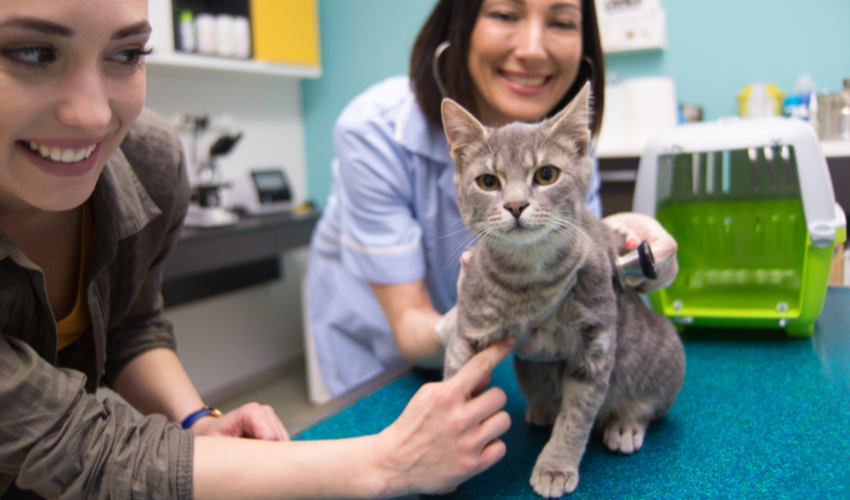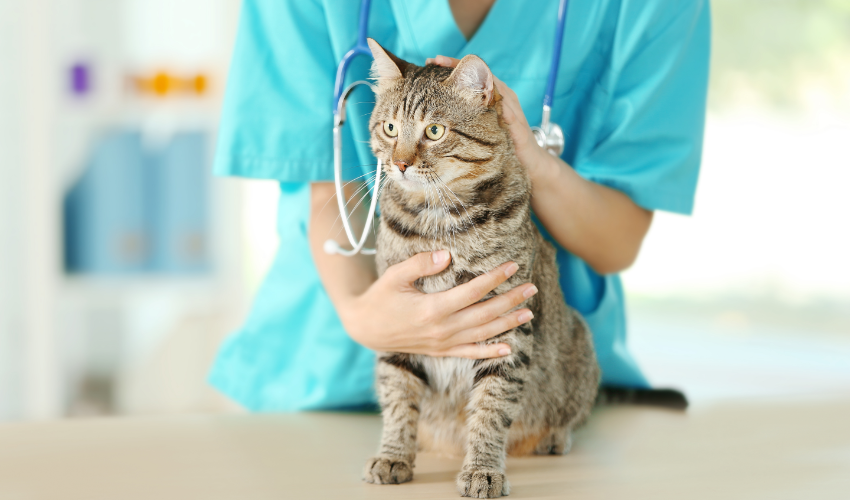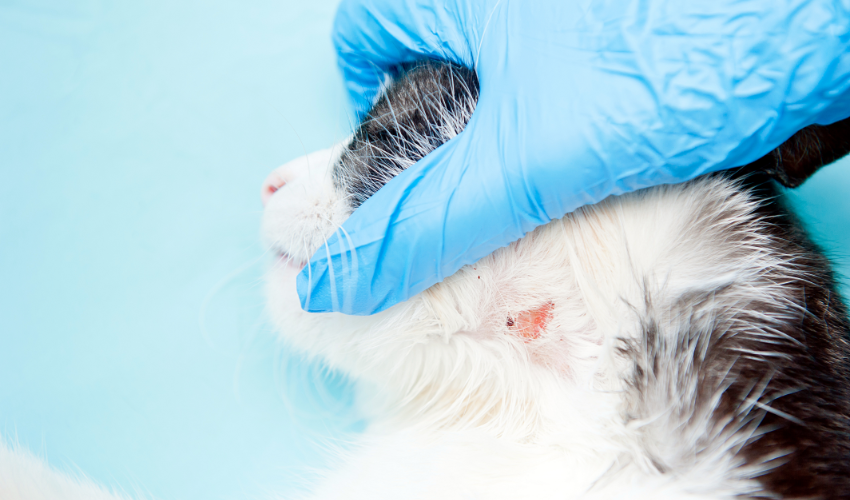Ringworm is a common fungal infection that can affect cats, causing hair loss, skin irritation, and itching. It is important to seek veterinary care if you suspect that your cat may have ringworm, as the infection can be contagious to both other pets and humans. In this article, we will discuss the symptoms, causes, and treatments for ringworm in cats, as well as the steps you can take to prevent its spread. We will also cover the stages of healing for ringworm in cats, and what to look for to determine if your cat’s infection is improving. By understanding the basics of ringworm in cats, you can take the necessary steps to help your pet recover from this condition and prevent its spread.
What is a Ringworm (Dermatophytosis) in Cats?
Ringworm is a common skin condition in cats that is caused by a fungal infection. It is highly contagious and can spread quickly from cat to cat. It can also be spread to humans, so it is important to take precautions when handling infected cats.
Symptoms of ringworm in cats include:
- Round patches of hair loss
- Scaly or crusty skin
- Itching or redness
Diagnosis of ringworm in cats can be made through a skin scraping or fungal culture. Treatment of ringworm in cats typically involves a combination of antifungal medication and topical ointments or shampoos.
In severe cases, cats may need to be isolated to prevent the spread of infection to other pets or humans. It is important to clean and disinfect any items that may have come into contact with the infected cat, such as bedding, toys, and grooming tools.
Here are some steps you can take to help your cat heal from ringworm:
- Follow your vet’s recommended treatment plan. This may include antifungal medication, topical ointments or shampoos, and isolation of the infected cat.
- Keep the affected area clean and dry. Wash the area daily with an antifungal shampoo and use a topical antifungal ointment as directed.
- Provide a clean and healthy environment for your cat. Keep the litter box, bedding, and other items clean and disinfected to prevent re-infection.
- Limit your cat’s exposure to other pets and humans. If possible, keep infected cats isolated until the infection has cleared up.
- Support your cat’s overall health. A healthy immune system can help your cat fight off the fungal infection. Provide a balanced diet and adequate exercise, and keep up with regular veterinary check-ups.
What Does Ringworm Look Like On A Cat?
Ringworm in cats typically presents as circular patches of hair loss, with scaly or crusty skin and sometimes redness or itching. The patches may be accompanied by raised or inflamed skin and may spread over time. In some cases, the skin may be black and brittle, and the hair may break off at the skin’s surface. In severe cases, the patches may become infected and produce discharge. Ringworm can affect any part of a cat’s body, including the head, paws, and tail, but is most commonly seen on the head, ears, and forelegs.

Will cat ringworm go away by itself?
No, cat ringworm will not go away by itself. Ringworm is a fungal infection and requires proper medical treatment to be effectively managed and resolved. If left untreated, the infection can spread and become more severe, causing discomfort, hair loss, and potentially, secondary skin infections. It is important to see a veterinarian for proper diagnosis and treatment of cat ringworm. Your veterinarian may prescribe antifungal medication, topical ointments or shampoos, and may recommend measures to prevent the spread of infection to other pets and humans.
What Cures Ringworm in Cats?
Ringworm in cats can be effectively treated with a combination of the following methods:
- Antifungal medication: Your veterinarian may prescribe oral antifungal medication, such as itraconazole or terbinafine, to kill the fungal infection from within.
- Topical treatments: Topical treatments, such as medicated shampoos and creams, can be effective in removing fungal fragments from the fur and skin, and reducing symptoms.
- Environmental decontamination: It is important to clean and disinfect your cat’s environment, including bedding, toys, and other surfaces, to prevent the spread of the infection and to prevent re-infection.
- Monitoring: Close monitoring of your cat’s progress is important to ensure that the treatment is working and to make any necessary adjustments.
It is important to follow your veterinarian’s instructions carefully, and to complete the full course of treatment, even if symptoms have improved. In some cases, multiple treatments may be necessary to resolve the infection completely. If the ringworm does not improve after the recommended treatment, or if it worsens, it is important to see your veterinarian again for further evaluation and treatment.

Cat Ringworm Healing Stages
The healing stages of cat ringworm can vary, but the following are general steps of the process:
- Diagnosis and treatment initiation: The first step is to see a veterinarian for proper diagnosis and to initiate treatment, which may include antifungal medication, topical treatments, and environmental decontamination.
- Initial improvement: Within the first few days to a few weeks of treatment, you may notice improvement in your cat’s symptoms, such as reduced itching and redness, and less hair loss.
- Continued improvement: As the treatment continues, the infection should continue to resolve, and hair may start to regrow in areas where it had fallen out. Itching and redness should also decrease.
- Resolution: If the treatment is effective, the infection should eventually resolve completely, and your cat should be free from symptoms. It is important to continue treatment until your veterinarian has confirmed that the infection has cleared up.
- Monitoring: It is important to monitor your cat for any signs of re-infection and to continue environmental decontamination measures to prevent re-infection.
The duration of the healing process can vary depending on the severity of the infection, the type of treatment used, and the response of the individual cat. It is important to follow your veterinarian’s instructions carefully, and to contact them if you have any concerns or if symptoms worsen.
How do I know my cats ringworm is healing?
You will be able to tell if your cat’s ringworm is healing if you see the following signs:
- Reduced itching: Your cat should experience less itching and scratching, which can be a sign that the infection is resolving.
- Improved skin appearance: The affected areas of the skin should look less red and inflamed, and may even start to look more normal.
- Regrowth of hair: Hair may start to regrow in areas where it had fallen out, which can be a sign of healing.
- Decreased fungal fragments: The presence of fungal fragments in your cat’s fur and environment should decrease as the infection improves.
- No new symptoms: Your cat should not develop any new symptoms, such as new areas of hair loss or skin irritation, as the infection resolves.
It is important to follow your veterinarian’s instructions for treatment, and to continue treatment even if symptoms improve, until your veterinarian has confirmed that the infection has cleared up. If you have any concerns or if symptoms worsen, it is important to contact your veterinarian for further evaluation and treatment.

Will bathing a cat help with ringworm?
Yes, bathing a cat can help with ringworm by removing fungal fragments from their fur and skin. However, it should be done in conjunction with other treatments recommended by a veterinarian, such as antifungal medication and topical ointments or shampoos. The use of a medicated shampoo specifically designed for ringworm can be effective in killing the fungal spores and reducing the severity of symptoms. It is important to follow your veterinarian’s instructions carefully, and to continue the treatment until the infection has cleared up, as instructed. If the ringworm does not improve after the recommended treatment, or if it worsens, it is important to see your veterinarian again for further evaluation and treatment.
How did my indoor cat get ringworm?
Indoor cats can get ringworm from various sources, including:
- Direct contact with infected animals: If your cat comes into contact with another infected animal, such as a stray cat or dog, they may become infected with ringworm.
- Contaminated objects: Ringworm can survive on objects such as brushes, combs, and bedding, and can be transferred to a cat if they come into contact with these contaminated items.
- The environment: Ringworm can survive in the environment for long periods of time, and if an indoor cat comes into contact with contaminated surfaces, they may become infected.
- People: Ringworm is highly contagious and can be spread from humans to cats. If a person with ringworm touches an infected area and then handles their cat, the infection may be transmitted.
It is important to take precautions to prevent the spread of ringworm and to seek prompt veterinary care if you suspect your cat may have contracted this fungal infection.

How do you clean a house with ringworm in a cat?
Here are some steps to clean your house if your cat has ringworm:
- Isolate the infected cat: Keep the infected cat isolated in a separate room with its own litter box, bedding, and food and water dishes to prevent the spread of the fungal spores.
- Clean and disinfect: Thoroughly clean and disinfect all surfaces in the room, including bedding, furniture, and toys. Use a disinfectant solution such as 1:10 dilution of household bleach, and let it sit for 10 minutes before rinsing and air-drying.
- Wash contaminated items: Wash all bedding, clothing, and toys that have come into contact with the infected cat using hot water (minimum of 140°F) and laundry detergent. Drying the items on high heat for at least 30 minutes will also help kill the fungal spores.
- Vacuum regularly: Vacuum all carpets, rugs, and flooring in the house to remove any fungal fragments that may be present. Dispose of the vacuum cleaner bag immediately after use.
- Monitor your other pets: Check your other pets for signs of ringworm and see a veterinarian if you suspect they may have been infected.
It is important to maintain good hygiene practices to prevent the spread of ringworm and to follow your veterinarian’s recommendations for treating the infected cat. Repeat the cleaning process as necessary until the infection has cleared up.
Conclusion
In conclusion, ringworm is a common fungal infection in cats that can cause hair loss, skin irritation, and itching. With proper diagnosis and treatment, it is possible for cats to fully recover from this condition. It is important to take steps to prevent the spread of ringworm, such as regularly cleaning your home and washing your hands after handling your infected cat. By following your veterinarian’s instructions and being vigilant about your pet’s health, you can help your cat recover from ringworm and prevent the spread of this infection to other pets and people.
If you suspect that your cat has ringworm, it is important to seek veterinary care right away. Early diagnosis and treatment can help to improve your cat’s symptoms and prevent the spread of the infection. If you have any concerns or if symptoms worsen, it is important to contact your veterinarian for further evaluation and treatment. With proper care, your cat can fully recover from ringworm and enjoy good health once again.
